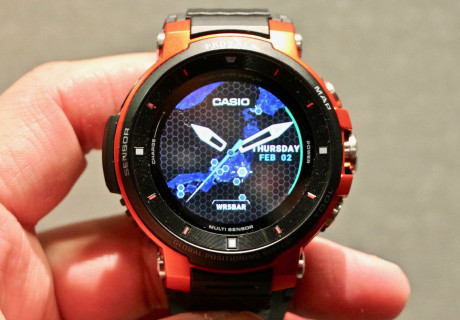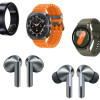Hands On with the Casio ProTrek WSD-F30 Smartwatch
Aug 29, 2018, 10:48 AM by Eric M. Zeman

Casio's latest watch is a smarter wearable. The WSD-F30 boasts a smaller footprint than its predecessor, making it easier to wear. Moreover, it ships with the newest version of WearOS and includes nine dedicated fitness apps. Here are Phone Scoop's first impressions of the Casio ProTrek WSD-F30.
Casio showed off the WSD-F30 in Berlin, a new WearOS-based smartwatch for the outdoor adventurer types. The hardware is similar to the 2017-era F20, but makes some noticeable changes that should have enthusiasts smiling.
Size matters. The F20 was an absolutely humongous watch. That's why Casio took pains to make the F30 a bit smaller. The company says the wearable is 3.9mm narrower and 0.4mm thinner. The difference is real. When compared to the F20, the F30 looks significantly smaller. The reduced footprint, of course, makes the wearable more comfortable to slap on your wrist.
Other than that, the F30 looks like a fitness watch and acts like a fitness watch. There are three hardware buttons on the right side that handle dedicated tasks such as opening the main menu, starting/stopping workout apps, and accessing the tools. The buttons are incredibly large, which makes them easy to locate. The travel and feedback was pretty good. The left side of the watch includes a speaker and Casio's proprietary charger.
Right Side

One of the biggest missteps is the F30's lack of a heart rate monitor. That may really irk some health and fitness folks who want to track their heart rate during workouts or throughout the day. Instead, the bottom is a solid piece of shiny metal.
Left Side

The F30's chunky bezel includes a set of stationary lines to mark the hours. The screen itself measures 1.2 inches with 360 by 360 pixels. I found it to be plenty bright in the dark event space; I didn't get to test it outdoors. This size and pixel density offers more than enough resolution for the size.
The F30 includes Casio's low-power mode that turns the full-color display into a monochrome screen. Casio calls this multi-timepiece mode. It displays only the time and sensor data. This dramatically reduces power consumption. Casio claims the F30 will last for a full month in multi-timepiece mode.
The device runs Google's WearOS, the newest version thereof that was announced the same day as the F30. It clearly focuses on just a few behaviors, including notifications, Assistant, and fitness. Swiping up, down, left, and right calls up these specific functions. You can then tap on individual notifications or apps to dig in and discover more.
The F30 boasts something Casio calls wearable maps. With this is a feature, you can download maps for offline use and the GPS radio will show you where you are in real-time even without an active connection to your phone or network. The maps are detailed, showing all types of roads/trails, as well as contour and geographical points of interest, such as mountain tops and rivers/streams. This feature could mean the difference between life and death when people become lost and/or injured out in the wilderness.
Casio hasn't said how much the WSD-F30 will cost. Sadly, last year's watch cost close to $500. Hopefully that won't be the case with the F30.
Comments
No messages
















 Samsung Upgrades its Wearables
Samsung Upgrades its Wearables
 Galaxy Ring Joins Samsung's New Wearable Lineup
Galaxy Ring Joins Samsung's New Wearable Lineup
 Apple Watch Goes Ultra
Apple Watch Goes Ultra
 Google's Pixel Watch is Here
Google's Pixel Watch is Here
 Apple Watch Series 9 Detects Finger Gestures, Brings Siri On-Device
Apple Watch Series 9 Detects Finger Gestures, Brings Siri On-Device








